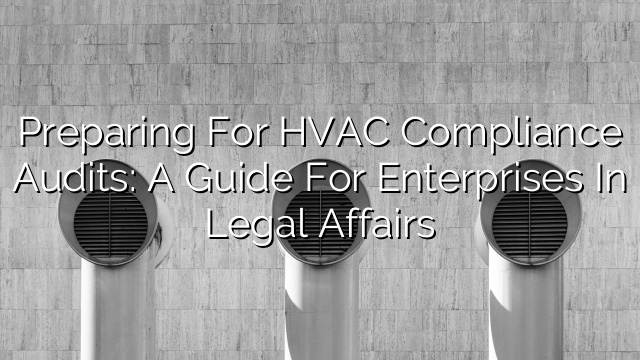Introduction
When it comes to legal affairs, enterprises have a wide range of regulations and compliance requirements to adhere to. One such regulation is the HVAC compliance audit, which ensures that Heating, Ventilation, and Air Conditioning (HVAC) systems meet the required standards for energy efficiency and environmental impact.
Preparing for HVAC compliance audits can be a challenging task, but with the right information and planning, enterprises can streamline the process and ensure that their HVAC systems are in compliance. In this guide, we will explore the steps and best practices for preparing for HVAC compliance audits.
1. Understand the Regulations and Standards
The first step in preparing for HVAC compliance audits is to familiarize yourself with the relevant regulations and standards. Depending on your location and industry, there may be specific regulations that apply to your HVAC systems. Some common regulations include the Energy Efficiency Directive (EED) in the European Union and the Title 24 Energy Code in California, USA.
It is important to understand the requirements of these regulations, such as energy efficiency targets, emissions limits, and maintenance requirements. This will help you assess the current state of your HVAC systems and identify any areas that need improvement to achieve compliance.
2. Assess Your Current HVAC Systems
Once you have a clear understanding of the regulations, the next step is to assess your current HVAC systems. This involves conducting a thorough audit to determine the energy efficiency and environmental impact of your systems.
You can start by gathering relevant information about your HVAC systems, such as age, capacity, and maintenance history. You can also collect utility bills to assess energy consumption. This information will help you identify any potential areas of non-compliance and prioritize actions for improvement.
3. Identify Areas for Improvement
Based on the assessment of your current HVAC systems, you may identify areas that need improvement to achieve compliance. This could include upgrading outdated equipment, improving insulation, or implementing energy management systems.
It is important to prioritize these areas based on their impact on compliance and cost-effectiveness. Consider conducting a cost-benefit analysis to determine the return on investment for each improvement. This will help you allocate resources efficiently and prioritize actions that will have the greatest impact on compliance.
4. Develop an Action Plan
Once you have identified the areas for improvement, the next step is to develop an action plan. This plan should outline the specific actions you will take to achieve compliance, along with timelines and responsibilities.
Consider involving key stakeholders, such as facility managers and HVAC contractors, in the development of the action plan. This will ensure that there is a shared understanding of the goals and responsibilities and increase the likelihood of successful implementation.
5. Implement and Monitor the Action Plan
With the action plan in place, it is time to implement the identified improvements. This may involve installing new equipment, conducting maintenance activities, or training staff on energy management practices.
It is important to monitor and track the progress of the action plan to ensure that the desired improvements are being achieved. Regularly review energy consumption data and conduct spot checks to verify compliance. This will help you identify any issues early on and take corrective actions as needed.
6. Document and Maintain Compliance Records
Throughout the preparation process and after implementing the improvements, it is crucial to document and maintain compliance records. This includes keeping records of maintenance activities, equipment upgrades, and energy consumption data.
Having well-documented compliance records will not only help you during audits but also demonstrate your commitment to sustainability and compliance with regulations. Consider implementing a centralized system for record-keeping to ensure that the information is easily accessible and organized.
FAQ
1. What is an HVAC compliance audit?
An HVAC compliance audit is a process of assessing whether HVAC systems meet the required standards for energy efficiency and environmental impact. It ensures that enterprises are complying with relevant regulations and standards.
2. What regulations apply to HVAC systems?
The regulations that apply to HVAC systems vary depending on the location and industry. Some common regulations include the Energy Efficiency Directive (EED) in the European Union and the Title 24 Energy Code in California, USA.
3. How do I prepare for an HVAC compliance audit?
To prepare for an HVAC compliance audit, you should familiarize yourself with the regulations, assess your current HVAC systems, identify areas for improvement, develop an action plan, implement and monitor the plan, and document compliance records.
4. What are some areas for improvement in HVAC systems?
Areas for improvement in HVAC systems can vary depending on the specific systems and regulations. Some common areas for improvement include upgrading outdated equipment, improving insulation, and implementing energy management systems.
5. How can I maintain compliance with HVAC regulations?
To maintain compliance with HVAC regulations, it is important to conduct regular audits, implement necessary improvements, and document compliance records. Monitoring energy consumption and conducting spot checks can also help identify any issues and take corrective actions.







